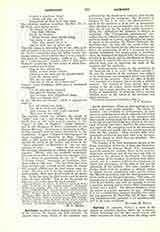

Sacristan, an officer who is charged with the care of the sacristy, the church, and their contents. In ancient times many duties of the sacristan were performed by the doorkeepers (ostiarii), later by the mansionarii and the treasurers. The Decretals of Gregory IX (lib. I, tit. xxvi, “De officio sacristae”) speak of the sacristan as if he had an honorable office attached to a certain benefice, and say that his duty was to care for the sacred vessels, vestments, lights, etc. Nowadays the sacristan is elected or appointed. The “Caeremoniale episcoporum” prescribes that in cathedral and collegiate churches the sacristan should be a priest, and describes his duties in regard to the sacristy, the Blessed Eucharist, the baptismal font, the holy oils, the sacred relics, the decoration of the church for the different seasons and feasts, the preparation of what is necessary for the various ceremonies, the pregustation in pontifical Mass, the ringing of the church bells, the preservation of order in the church, and the distribution of Masses; and finally it suggests that one or two canons be appointed each year to supervise the work of the sacristan and his assistants.
The undersacristan (custos) is also mentioned in the Decretals (lib. I, tit. xxvii, “De officio custodis”). He was the assistant of the sacristan, was subject to the archdeacon, and discharged duties very similar to those of the sacristan. Now the office is hardly ever attached to a benefice, but is usually a salaried position. The Council of Trent desired that, according to the old canons, clerics should hold such offices; but in most churches, on account of the difficulty or impossibility of obtaining clerics, laymen perform many of the duties of the sacristan and undersacristan.
—J. F. GOGGIN.
ALTAR SOCIETIES.—There are altar societies in connection with most parish churches. The duties of members vary according to circumstances, in some instances including those which ordinarily fall within the sacristan’s province, such as the vestments and altar vessels, making ready for the priest’s Mass, and so on, but as a general thing they consist of the payment of yearly dues into a fund for the maintenance and repair of the accessories used in the ceremonies of the Church and usually also of a certain amount of labor for this purpose. Altar societies differ from tabernacle societies in that their work is for the benefit of the church to which they are attached. (See Tabernacle Societies).
The Sodality of St. John Berchmans, known as the Pious Association of Servers of Mass and Sacristans, was founded by Vincent Basile, S.J., missionary Apostolic among the southern Slays, for lay acolytes, choir boys, sacristans, and all who have any duty to perform in the services of the Church. Its object is to induce all its members to perform their duties piously and in a manner befitting the ceremonies in which they participate, for the glory of God and the edification of the faithful. The rules compiled by Father Basile bind the members to absolute silence in church, devout genuflexion when passing before the Blessed Sacrament, and the clear pronunciation of the words of the liturgical prayers. This same circumspection is expected to characterize their conduct even in the sacristy, and they are required to attend a monthly meeting and to receive Holy Communion at least once a month. The director should be either the pastor or a priest appointed by him. Although it is not a confraternity properly so-called, this sodality was approved by Pope Pius IX, September 21, 1865, and indulgences were accorded to its members, subject to the usual conditions.
BLANCHE M. KELLY

